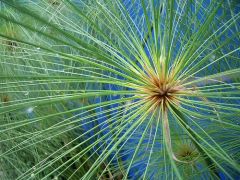Papyrus - Cyperus Papyrus
The papyrus plant is a reed that grows in marshy areas around the river Nile in Egypt. The inside of the triangular stalk was cut or peeled into long strips. These strips were then laid out in two layers, one horizontal and one vertical, one pressed and dried to form a papyrus sheet.
Many of the sheets were then joined end-to-end to form a roll. No glue was required; instead, the natural gum of the plant held the sheets together. A roll was usually about one foot in height and could be up to 100 feet in length.
Besides its use for producing a medium for writing purposes, papyrus was also used for mattresses on beds, for building chairs, tables, and other furniture as well as for mats, baskets, boxes, sandals, utensils, rope and boats. Furthermore, the papyrus root was a source of food, medicine and perfume.
Papyrus was ancient Egypt's greatest export and it revolutionized the way people kept valuable information. No substitution for papyrus paper could be found that was as durable and lightweight until the development of pulped paper by the Arabs. Pulped paper was far easier to produce but not as durable. This not only led to a decline in papyrus paper making, but also to a decline in the papyrus plant cultivation. Eventually, the papyrus plant disappeared from the area of the Nile, where it was once the lifeblood of ancient Egypt.
More on Wikipedia.
